
110 CAMERAS

My, there sure were a lot of 110 cameras made. But in the end the 110 cameras were destroyed by their success. First, it competed against the readily-available, easy-to-use 126 INSTAMATIC cameras, already on the market. In order to compete, manufacturers kept adding more and more features to the super-small 110 cameras. At the same time, the 35mm rangefinder cameras were getting smaller and smaller. Soon, feature-laden 110's -- with built-in flashes, motor drives, etc. -- were bigger and even more expensive than good-quality 35mm cameras -- with lower-quality results. The 110's were squeezed from both sides. Consumers correctly chose the 35mm cameras.
This list is inaccurate and very incomplete. Typically, these cameras were very simple and specifics were never listed by the manufacturer. Since so many styles and types were made, it is impossible to list them all. Many camera models were sold under various brand names. If you are able to provide more accurate information than is listed here, please contact us.
Although films of various types were available for 110 cameras, the cameras could only be set for 100 ISO or 400 ISO. In fact, the earliest 110 cameras were only designed to use 100 speed film. You can tell if a particular camera is designed for both films by checking the inside of the film chamber. The film cassette has a tab on the end to tell the camera what type of film it is, and if the camera has a small "arm" to sense the film cassette, it can be used with both film types. There are other 110 cameras that have a switch on the exterior of the body to tell the camera what type of film is being used. You can physically use either film in a camera designed for only ISO 100 film, but the exposure will be the same for both types of film. In the cameras designed for both films, the exposure changes when the ISO 400 cassette is sensed -- so you have to get the right type of cassette for the film or modify the cassette to fit. A few 110 cameras had exposure compensation dials built-in, so that the ISO of the film can be changed if desired.
110 film is still available -- check out The Camera Shop for details. Processing can be found anywhere. And 110 cameras are still being manufactured, but you are more likely to find them at your local Walmart than at the local camera shop. There were some very high quality 110 cameras made and this category should not be overlooked as mere "toy" cameras. Many were equal in quality and features to the best 16mm cameras -- some would say 35mm as well.
110 film is really 16mm film with special perforations along one edge. The perforations were used on most 110 cameras to cock the shutter and position the film correctly, but it is possible to reload the 110 cassettes with 16mm film. Check out the Darkroom for details.
Same as the Hanimex 110 micro.
See Eiko cameras.
see British Airways, Transavia, Icelandia, etc.
It was a re-badged Haking camera, with a fixed-focus, fixed aperture lens, and a fixed shutter speed (1/80s). It has flash capability with a Flip-flash socket. It was sold under many other names, such as the Caprice Pocketpak 330, Porst Pocket 1000F, Carena Pocketpak 330, 3M Pocketpak 330, Olympia Pocketpak 330, Bilex Pocketpak 110 330 -- you get the idea.
80mm (f11.0), fixed-focus lens. Mechanical shutter with speed of 1/125. No exposure control. The camera looked like a binocular/camera combination, the binoculars were fake, but because of the 80mm lens, the results are telephoto. There was a small viewfinder underneath the camera lens. Dimensions of 2-1/8 x 4 x 3-3/4 in. Focusing wheel and tripod socket on the bottom, and shutter release button with cable release socket on the top. Also sold as the Sedic Tele-Spot 110 and the ITT IC 407.
(1986) It's the same as the Micro 110 packaged in a cylindrical can (see below), but with a different label. This is not to be confused with "CAN" cameras (also, see below) which are cameras built into cans. This camera was just packaged inside a tin can. Once you open the can and take out the camera, you throw away the can -- unlike with "normal" "can cameras".
see ASAFLEX
see Pentax 110
see Orinox
see Estes Astrocam
see Lomography 110 cameras
It's not marked with a name, just a BEE on the front. It's a basic 110 for kids with the same design as the Kodak-Fisher-Price 110 -- rubber bumpers on each end, that is. Takes a flip-flash.
See Besa 16
A 110 camera manufactured by the Kiev/Arsenal plant which produced countless Besa/Bera/Kiev/Vega 16mm cameras, but apparently this 110 model never made it into production. It had a manual selection of the f-stop, and a focusing lens with controls on the top plate. The shutter was controlled by a battery-powered CdS cell on the front to set the correct exposure. It is a typical bar-shaped 110 without a flash, but it did have a hot shoe. Very sophisticated -- maybe that's why it never made it into production.
An interesting twist on keychain cameras. Undoubtedly sold under under other names.
See Eiko cameras.
see Tasco
See Lure
See Webster's Dictionary Book 110 Camera
Boots is best known for its disc cameras, but they made at least one 110 camera as well. This one has two lenses and sports a built-in flash.
Another airplane camera, but not the same as the Transavia and Icelandia. This one is a complete airplane, but oddly shaped. One of the plane's wheels advances the film and the other is the shutter release.
See Helm cameras
See Eiko cameras.
This isn't really a camera -- until you put it together! It's a kit with all the parts and tools -- even an instruction book and a roll of film. The good thing about it is when something goes wrong, you can take it apart and fix it!. See also the U-Build 110 Pocket Camera.
An Ansco 50 that was given away by Burger King.
See Eiko cameras.
Simple 110 camera in a yellow package.
See Eiko cameras
There is nothing deluxe about this camera.
A big step up from the Capital Deluxe 110, this is a disguised 110 with a similar fixed lens and shutter -- disguised as a cheap 35mm camera. It looks just like a typical, cheap 35mm camera, but it is, in fact, a cheap 110 camera instead! It's redeeming quality is that it has a HOT SHOE -- no kidding -- so if you have an automatic flash, you can turn this into an auto-exposure, 110 camera. Sold as the visions RS-110 -- and probably others.
see Argus cameras
see Kraft Cheesasaurus Rex Super Sleuth
See Eiko cameras.
See Lumiere Cil 1 110
110 camera with sliding lens/viewfinder cover. In shape and size it looks more like a 35mm camera. Various colors. 20mm (f5.6). Hot shoe.
It's a typical keychain 110 camera with a few, small differences. First, it has a sliding lens cover, and probably came is different, bright colors. In addition, it's on a wrist strap, not a keychain -- but a keychain can be substituted.
See Kiddie cameras.
A basic keychain 110 camera, but alos sold as a "110 Can" camera -- see also EIKO cameras.
See Bencini cameras.

Made by Cony Industries in Japan, it's triple the fun. It's a 110 camera with a fixed-focus, 70mm f11 lens (no focusing needed), 2.5X (125mm) binoculars, and a radio -- all in one -- kind, sorta. It has a single shutter speed of 1/125s. The 110 camera snaps on top of the binoculars when you want to take a picture (that's the only way to know what you're taking a picture of), and the earplug for the radio (it lacks a speaker) plugs into the front of the binoculars.
See Concord 110 cameras.
It has a flip-over cover that turns into a handle. Other than that it appears pretty basic, but it has an interesting switch on the top that appears to select for 100 or 400 speed film, but it does more than that. While the camera has a fixed shutter speed, it has two aperture settings -- "open" and "stopped down". For 100 speed film, there is only one selection on the switch. That opens up the aperture for daylight, but you can add a Flip-flash for lower light situations. For 400 speed film, you can set the lever for sunlight (stopped down) or for cloudy/flash use (opened up). It was also sold as the Halina 110 Auto-Flip, the Haking Grip-C, and the Hanimex Auto-Grip 110F.
See Superheadz Fisheye
See Eiko cameras.
110 keychain-type camera with wrist strap
see Lomography 110 cameras
See Eiko cameras.
A large keychain camera.
See Eiko cameras.
(1979) When the factory isn't on fire -- don't laugh, it's happened -- Estes makes "toy" rockets in Penrose, Colorado. It's actually a good place for them, since Penrose has LOTS of open space. They made various rockets with various "improvements", such as this particular rocket which incorporates a built-in 110 camera. It may only be a single-element meniscus lens, so don't expect Minox quality.
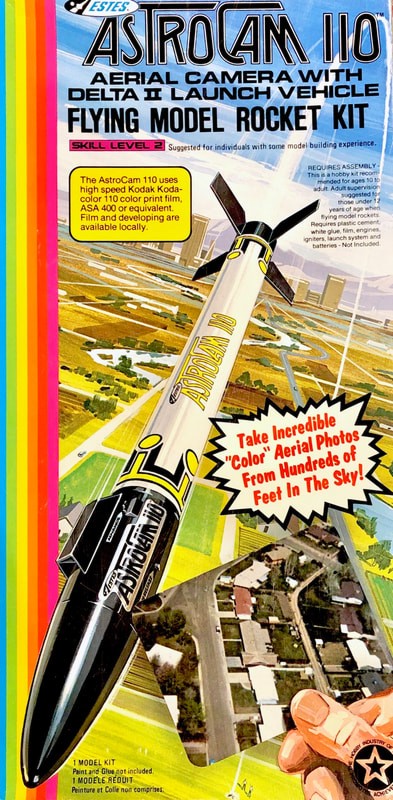
The rocket goes up, the camera is ejected, one picture is taken at 1/500s, and the camera safely returns to earth via a parachute -- if you are lucky. In any event, you get to spend the rest of the afternoon trying to locate the camera and the rocket so you can use them again. Better count on no more than a few flights per model because there are a lot of great rocket-catching trees out there to contend with. For those who prefer a vicarious approach to rocket photography, there are plenty of rocket aerial photography web sites, such as http://straylight.ml.org/~grumbine/rap.shtml. It's obvious that some people have too much time on their hands.
See Keystone cameras.
Apparently there was at least one 110 camera that was sold under the Exacta name. It's likely that it was not made by Exacta, and it bares a resemblance to other European 110 cameras of the time.
See Film Corporation of America
See Reese's
See Eiko cameras.
A bare-bones 110 made by Haking. It's the same camera as the Hanimex Pocket 200. It's main feature is that it takes Magi-cubes. It was undoubtedly given away as some sort of promotion -- or perhaps it was simply a (tax ?) scheme of some sort. The only clue is that so few were made that are very hard to find -- even if you want to look for one. It is marked "Film Corporation of America" on top, and "FCA" on the front. Yes, there is such a company -- at least on paper, in Delaware, since the 1960's!!! So at least they sold a camera, if not any actual film or films. Contact them directly if you are interested in being on their Board of Directors. And if you find a Pocket 100 or 300, please let us know -- the IRS might be interested as well.
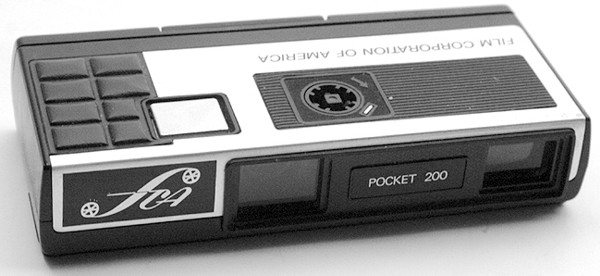
see Lomography 110 cameras
See Eiko cameras.
see Rollei
see Eiko
There are actually two cameras named "FUN GEAR 110 CAMERA" and both are made by the same company. The smaller one is a large keychain-type 110 camera, but with a wrist strap instead of the key chain. It is the same camera as the Mini Shot 110 compact (below) -- and also sold under other names, as well. It is different from the true 110 chain cameras in that the 110 cassette is completely covered by the camera.
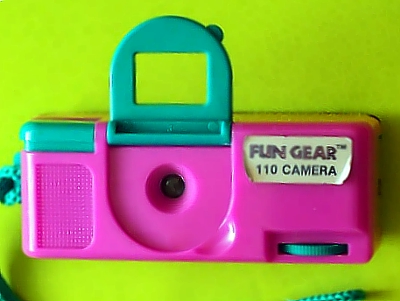
The other Fun Gear 110 camera is too large to be considered a key-chain camera but is basically the same model -- only taller. It also has a sliding front cover like the Olympus XA 35mm cameras. Both cameras have a flip-up viewfinder and come in bright fluorescent body colors.
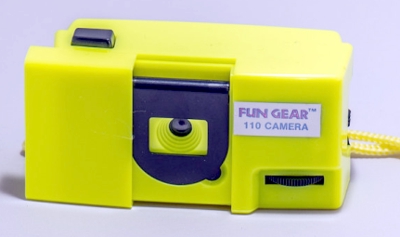
See Keystone cameras.
(1988-89) Inexpensive 110 camera designed to show students the internal working of the camera.
An very hard-to-find, simple, inexpensive 110 camera with two unusual features. In addition to being marked "Made in Singapore", it has a HOT shoe for a flash. Sold under other names, of course.
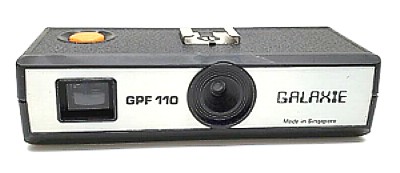
See Eiko cameras.
See Juhasz Glink
(1989) 110 camera in French national colors to celebrate the French Revolution. Same as the Halina Revolution 89.
See Eiko cameras.
see Sanrio Hello Kitty camera
see HG cameras
(1983) You've heard of clock radios. And you've heard of camera radios. So how do you improve upon these ideas? How about adding a 110 camera to a clock radio? Depending on how you look at it, you have a large 110 camera with a radio, and a clock -- or a clock with a radio and a camera -- or...... What the heck, let's add in a flashlight and several other things too! Did I mention that it even has a built-in electronic flash for the camera -- or emergency beacon!!!
Despite the name this camera did not have a built in flash. It is a fairly small bare-bone 110 that accepts flip-flash bars.
It's a 110 keychain camera without the keychain. It has a more useful wrist strap. Single speed of 1/60 and fixed f8 aperture -- OK for sunlit scenes! Same as the Hot Shot II.
A 110 camera keychain camera with typical features -- or lack there of!!!
How do you improve on perfection? Just give it a new name! The Hot Shot II is the same as the Holga Micro 110 camera (above). The lens is 25 mm (f8) fixed-focus. The instructions say that the lens is set for 1 meter. If they mean that the point of focus is 1 meter, the depth of field would be from 2 feet to about 12 feet. The shutter speed is listed as 1/120 seconds so the camera was designed for ISO 400 speed only. It weighs in at weight 20 grams and measures 3 1/4" x 1 3/8 " x 1 3/16 ". Made in Taiwan by Hyman Products Inc.
Yet another "theme" 110, this one has a built-in flash, Hulk Hogan faceplate, and even imprints an image of Hulk on each picture.
A 110 camera built into an airplane model. Apparently sold or given away by several airlines, such as Transavia, and Icelandia. The nose-cone drops down to expose the lens and the cockpit flips up to make a viewfinder.
see Superheadz flash cameras
It was also sold under the Fun Gear name (above), Quelle (below), and many other labels
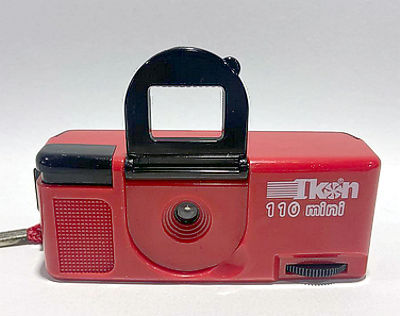
see Soulmates In-B-Teens camera
A keychain 110 camera but with an upside-down configuration.
110 camera built into a big egg.
A promotional keychain camera from Kellogg.
These are ubiquitous, small 110 cameras where the 110 cassette forms some or most of the body of the camera. The camera itself is just the lens and a film advance dial which snaps onto the front of the 110 cassette. Needless to say, these cameras are very inexpensive to make and are often seen as promotional give-aways. They are frequently built with a keychain ring -- hence the name. Despite the size of the camera and the single element plastic lens, the quality is acceptable if you can live with fuzzy edges in the pictures -- similar to the Diana camera. The single shutter speed and single aperture sure makes exposure determination easy! All of the names of these various keychain cameras cannot be listed here, but see Ansco 50, Micro 110, Holga, Lomography, Mini 110, Torel, Coca Cola, Vivitar Micro 110, Kellog's, etc. -- just to name a few.
See Besa 16
A keychain 110 camera with Kitkat candy bar logo.
In some ways the wacky colors and designs make up for its lack of features.
See Vivitar LA Brites
See Eiko cameras.
A bare-bones, re-badged, Hanimex Micro 110 given away by the French Post Office???
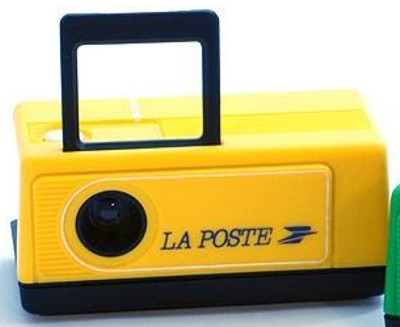
It may be hard for some people to believe, but Leica made a 110 camera. But it would be more accurate to say that they PLANNED to make a 110 camera. In 1974, Leica made a prototype 110 camera, but the camera was never actually produced and marketed. How many prototypes are out there is still a mystery, and this is one reason why they get such fantastic prices at auction when they show up -- tens of thousands of dollars! The camera looked like most 110 cameras -- pretty basic -- but the Leica 110 had all the extra touches, such as built-in sliding lens cover, focusing lens, built-in CDS meter, extra large viewfinder and more.
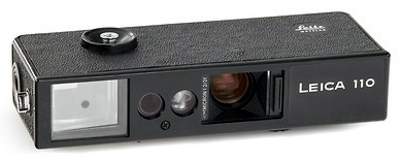
For a 110 camera, it has an amazing array of features -- while the top appears bare-bones, it has controls on the
bottom. Rangefinder focusing from 2' to infinity with a focusing scale visible on the top of camera, automatic
parallax correction in the viewfinder, 25mm f2.8 lens, aperture-priority auto-exposure, apertures selectable from
f2.8 - f16, apertures visible in the viewfinder, electronic shutter automatically sets the correct shutter speed
from 1/1,000 to 4 seconds, over- and under-exposure warning lights in the viewfinder. WOW!!!. If you're unable
to find or afford a Leica 110, perhaps you should consider a Balda 110 (see above) made with some help from Minox
instead.
110 camera by LeClic. Shaped like the Pentax 110, but that's where the similarities end. This is a viewfinder camera, not an SLR. It comes in various colors with a bright yellow, O-ring-sealed case for use at the beach -- but the camera is NOT waterproof.
See Wild Planet
See Lure
A key-chain type camera
Lumiere made a lot cameras, starting in 1928. They only made one 110 camera; the "CIL" in the name is an abbreviation of "Ciba", "Ilford", and "Lumiere" -- the conglomerate that manufactured and marketed the camera. It is a simple 110 camera with a single shutter speed, a fixed focus lens and a fixed aperture (sunny). It accepts flash cubes and has a sliding cover for the lens. It was available in two "colors" -- black ends or orange ends.
Often reported to be a 110 camera since it looked exactly like one -- and it operated exactly like a 110 camera. If fact, it used 16mm film -- so see the 16mm cameras section for details.
See Lure
Cheap 110 camera in imitation pack of Marlboros -- the viewfinder pops out of the bottom.
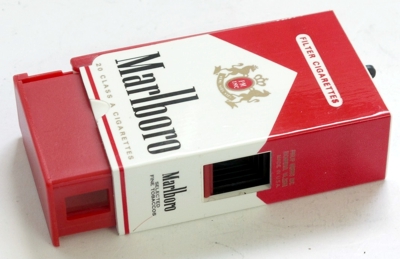
Not to be confused with the Lucky Strike, John Player (see 16mm cameras section) or any
other submini hidden inside an actual pack of cigarettes.
see HG cameras
See Superheadz Clamshell
110 camera in Micky's head. See also Helm cameras.
see Kodak 110 cameras.
see Helm cameras and Eiko cameras.
This must be the cheapest 110 camera in the world -- certainly as cheap as a single penny stock. The camera was undoubtedly sold by other companies -- but not as the "Mickey Wonders Why". In fact, the camera itself does not say "Mickey Wonders Why". It just comes with a decal with the name, and you have to stick it on yourself.
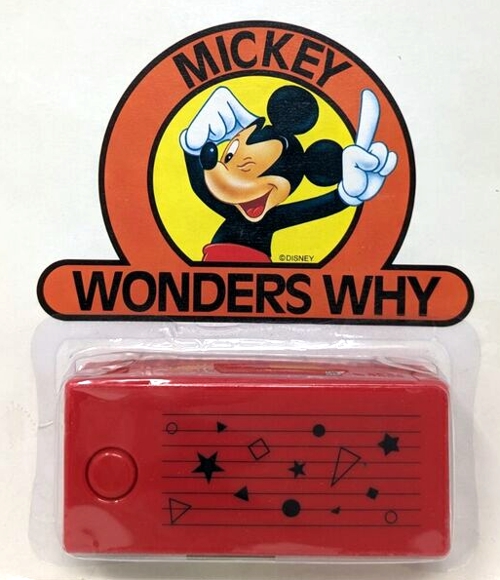
See Eiko cameras.
Not to be confused with the Mini 110 (below), the Mini110 is a keychain camera, but notable for its unusual design, but the features are the same as other keychain cameras -- fixed aperture and shutter speed.
Not to be confused with the Mini110 (above), this is a new and improved version of the Ansco 50 (above). It has the same basic design -- it's a half-camera and the 110 cassette pops onto the back. The improvements over the original are mainly cosmetic. This model comes in a variety of colors and the backside is more substantial, so that the camera looks neater when in place. In addition, the viewfinder is a two-sided pop-up version that gives a more accurate composition. Shutter speed of 1/100, more or less. Fixed-focus, f9 lens, more or less. Film advance wheel moved to the front of the camera. Comes with wrist strap. Same as the Hanimex Micro 110 (above).
Often sold or given away as a promotional item with a company logo. Pop-up viewfinder and keychain -- no extra charge!
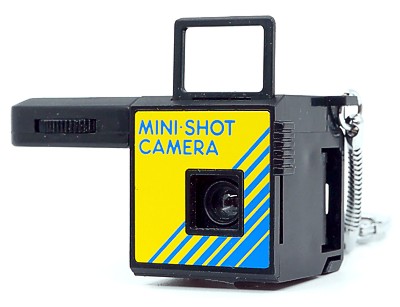
While the package is marked "My First Real Camera" (see below), the camera is marked "My Camera PG-1". As you might expect, it's pretty bare-bones, but has a wrist strap and a lens cover. Who knows the significance of the "PG-1"?.
See Kodak 110 cameras -- above. Not to be confused with My First Real Camera -- below.
See My Camera PG-1 -- above. Not to be confused with My First Camera -- above.
See Eiko cameras.
The Newport Alive with Pleasure 110 was really the Kalimar Micro 110 in green with orange buttons. You could get it for free when you bought enough of their coffin nails and mailed in a form -- assuming you were still alive.
The only thing worth mentioning about this bare-bones camera is that it wins the "Camera with the Longest Name of All-Time Award".
A bare-bones camera with a fixed lens & shutter -- but with a hot shoe. Sold under other labels such as Hanimex and Halina.
See Hendren
See Eiko cameras.
See Eiko cameras.
(1985) Fixed-focus lens. Built-in flash. Accepts 100 and 400 ISO film.
see Yashica and Argus cameras
See Eiko and Superheadz cameras.
See Eiko cameras.
see J.C.Penny
See Eiko cameras.
see American Rand Photo Binocular 110
Nothing De-Luxe about it -- just the barest of bare-bone 110 cameras.
see Bell and Howell Picture Master
Cheap 110 camera
Cheap 110 camera
See Build Your Own Pocket Camera 110 camera
(1982) A 110 camera in the shape of a tire. That's right, a car tire. The tire is about four inches across and weighs about four ounces. Potenza is a tire manufacturer, so it makes sense -- sort of. Needless to say, it is sought after by collectors and anyone else who needs a spare -- camera, that it.. The lens and viewfinder are in the hub of the tire. The lens is fixed focus but everything is sharp from five feet to infinity. See also EIKO if you're not too "tired".
see Helm cameras.
Very basic 110 camera with a fixed shutter and aperture. No flash option. It's the same as the Miranda Pocket Mini 110 P, the Birex Pocketpak 110 P, and many others.
It's the same, cheap 110 keychain camera as the FUN GEAR, MINI SHOT, etc. 110 cameras, this time used as a promotion for a large photographic company.
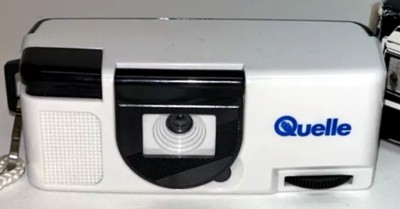
See National
See Lure
The camera says "Reese's" but the box says "FBI jr. Reese's". Either way, it's a simple 110 camera in the shape of a Reeses Peanut Butter Cups package. You don't hold the camera in the tyical bar shape of most 110 cameras, but rather on it's side. Comes with official badge. I'm sure there will be some sellers who will state that this was an official spy camera of the FBI!
See Halina and Haking
110 camera with a kitty on the front. 20mm (f4.0) lens. Single shutter speed. Built-in flash.
A key-chain-type 110 camera with a built-in viewfinder -- instead of the more common pop-up type. Still, it's bare-bones, and sold under other brand names, for sure. It was given away as a gift, for promotional purposes, etc. The one in this photo is labeled "BTM Transport" (a bus service company in Florida) on the top.
It's the size and shape of some 35mm underwater cameras, but it is a 110 camera that uses two AA batteries to power the built-in flash unit -- and the built-in motor drive. That's why it's so large. The camera has a 20mm f4.0, fixed-focus lens, and a single shutter speed of 1/125s. There are two aperture settings for SUNNY (f5.6), CLOUDY (f4), and FLASH (f4 w/flash). It also has a shutter release lock, and over-sized control knobs It is waterproof to 150 feet, and came in a Yellow or Orange body. It will work with 16mm perforated film, with a minor modification to the operating procedure. The motor drive will advance the film about 15mm when the perforations are in the path of the perforation sensor arm. Thus it appears to skip one perforation in the advance cycle. Therefore, by 'shooting' a 'blank' frame (i.e., firing the shutter with the lens covered such as with your hand) and allowing the motor drive to advance the film again it accepts perforated film without any frame overlap. This should place the frame separation at about 30mm instead of the normal ~25mm wasting a small amount of film. Who knows who actually made it, but it was also sold as the Hanimex Amphibian 110 MF.
An "art deco" kind-of, key-chain camera. Selby is better known for it's multiple image 35mm cameras, but they broke into the 110 market as well.
See Eiko cameras.
see Kraft Velveeta Shells and Cheese
A very simple 110 that was used by a drug company to advertise one of their prescription pills -- and undoubtedly used by many other companies for similar purposes.
see Eiko cameras.
See Eiko cameras.
see Helm cameras.
A typical keychain camera -- but with an unusual cover for the lens. FYI, it is NOT solar-powered, as far as we can determine!
110 camera sold with sunglasses -- not part of the camera. Sometimes sold with a separate pair of binoculars as well -- not part of the camera either!
A 110 camera given away by McDonald's. It has the general shape of many keychain cameras, but is substantially larger. It has various "safety" features that make it pretty child-proof. The film door can only be opened with a coin, and the typical pop-up keychain viewfinder is replaced with a permanent rugged viewfinder.
See Impulse
see Dupont Stren.
A basic 110 camera with a built-in flash in a curvy, black & red body. Undoubtedly sold under other brand names -- although not SUPA.
See Eiko cameras.
see Kraft Cheesasaurus Rex Super Sleuth
see Sedic.
see Eiko cameras and Potenza.
Not a titan in the 110 arena, it is a simple 110 camera, but with a relatively fast f5.6 lens and a built-in flash -- with ON/OFF switch and ready light -- using two AA batteries. Undoubtedly sold under other names.
See Eiko cameras (above).
Another keychain 110 in a variety of styles. One version has a flash attachment. Red, white and blue stars and stripes design on the front. The flash clips into a shoe on the top and connects with a short power cord with a standard PC plug. It is powered by one AAA battery.
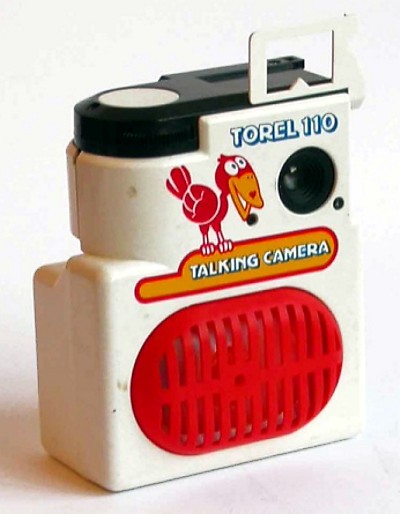
You know those dolls where you pull a string and it says "Mommy". That's the idea behind the Torel 110 Talking Camera. Press a button and a "large" speaker on the bottom of the camera says "Cheese". Otherwise it's a standard keychain-style camera.
A 110 camera built into an airplane model. Apparently sold or given away by several airlines, such as Transavia, and Icelandia. The nose-cone drops down to expose the lens and the cockpit flips up to make a viewfinder.
The only thing worth mentioning about this barest-of-bones camera is that it's one of the few 110 cameras that were built upside-down, so the viewfinder is on the opposite end of the camera, and the film advance is a dial on the top.
See Warner Brothers Tweety (below).
This isn't really a camera -- until you put it together! It's a kit with about 30 parts (it even includes a tiny screwdriver) and an instruction book. The good thing about it is when something goes wrong, you can take it apart and fix it!. And you could even order replacement parts if you needed to. It was marketed by the same folks that marketed Nikon cameras in the '70s -- EPOI, Inc. See also the Build Your Own Pocket Camera.
What it lacked in features it tried to make up for with bright colors. I take it back; it didn't even have bright colors!
Just a basic 110 camera with a built-in flash -- turned ON & OFF with a switch on the top. A ready-light indicates a full charge. It requires two AA batteries -- which are worth more than the camera. It's only been seen in a pale blue body and probably was a promotional product (like many simple 110 cameras) from the Vantage cigarette company -- mainly sold in the United States, but also sold in Canada, Argentina, Spain, Italy, Russia and Lebanon!!!
See Besa 16
see Kraft Velveeta Shells and Cheese
This is a cheap, disguised 110 with a fixed lens and shutter -- disguised as a cheap 35mm camera. It looks just like a typical, cheap 35mm camera, but it is, in fact, a cheap 110 camera instead! It's redeeming quality is that it has a HOT SHOE -- no kidding -- so if you have an automatic flash, you can turn this into an auto-exposure, 110 camera. Sold as the Capital 110 V30 label -- and probably others.
No, it doesn't take panoramic shots or have an extra large viewfinder. And there's absolutely nothing "deluxe' about it, either. It's just your bare-bones 110.
see Voigtlander Vitoret
It's just another bare-bones 110 with a fixed aperture lens and shutter speed -- but it does takes Magi-cubes and keep you fashionable, I guess. Probably sold under other various names as well.
See Impulse
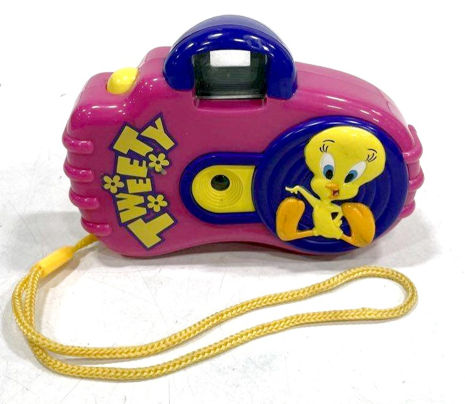
Even Warner Brothers couldn't avoid the 110 camera frenzy, and produced a simple, but unique & stylish, 110 camera for the Tweety lovers out there. Of course it has no features -- except a large viewfinder -- and it is stamped "WARNER BROTHERS CHINA" on the bottom, so who knows who made it?
See Hendren
A variant of the Agfa Happy, it's a basic 110 camera with no exposure control except for the use of a flip-flash. Like the Agfa, it has a Minox-style push-pull film advance and shutter cocking, but unlike the Agfa, it came in a variety of colors from all black, to beige, yellow, chrome or black & white.
Takes two AA batteries.
It's one step above a bare-bones 110 because it has a built-in flash. Uses two AA batteries and has a unique color.


To return to the main index for the Sub Club click here.
COPYRIGHT @ 1995-2025 by Joe McGloin. All Rights Reserved.